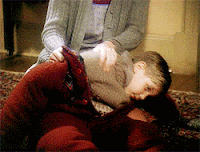What are some of the things that you associate with the word camping? Some people think of tents and campfires and s'mores while still others think of hiking, fishing, boating and the other glories of camping. But what people don't think about...is the winter. It's really quite a bummer that there are only a few "good weather" months out of the year in places like New York, Colorado, Alaska, and other outdoorsy states. Over the next week and a half I will uncover the fundamentals of winter camping in a 3 part series. Today's post will introduce you to the basics. The next 3 posts will dive further into the topics we touch on below.
 |
| Winter camp in the snow above lower Blue Lake, Sneffels Range, Colorado – October. (Photo Cred: Jack Brauer) |
- When planning a winter camping trip, pick a realistic destination. The Swiss Alps probably isn't a great place to go unless you are a seasoned, winter camper. Don't choose a place where there's a good chance of an avalanche. They're real. They happen.
- Once you've picked your destination, be sure to check the weather forecast to make sure you avoid a cold-front that might be on its way in.
- When packing the necessary gear, people usually don't put enough thought into food. Don't cheat yourself out of good food. Always, always make hearty meals. It makes the trip much more enjoyable. And bring plenty of snacks!
- Always let a family member and friend where you are going.
- Try to read reviews on the place that you choose to go to and talk to people who have been there if at all possible.
- It's always a good idea to carry cash with you just in case there are unexpected costs.
- Make a checklist of things you need to bring (i.e. read my upcoming posts in this series). But for now, I will give you a short overview of the things you will be needing to plan a great, winter camping expedition.
- Always plan to have your plans changed. Things will never go exactly according to plan and that's okay. Go with the flow and enjoy yourself!
There are a few basic things that we will cover over the next 3 posts: Tent/bag/pack, clothing, and accessories. Below, you will find a primer on these things that will hopefully get you excited to read the rest of this series.
TENT/SLEEPING BAG/BACKPACK
You're going to need a tent. A tent is probably one of the more important things to have when you go winter camping...because snow and wind. People have tried to camp with the standard 3-season backpacking tent, but they don't fare too well. The 4-season tent will be able to withstand stronger winds and heavier snow if it happens to snow while you're on the expedition. Stay tuned on my text post that will help you find the best tent.
When deciding on what kind of bag to get, the general consensus is that you should buy a bag rated at 10°F colder than the coldest temperature you expect to encounter. Speaking of cold, it can take a while to warm your sleeping bag with only your body heat. Boil some water, seal it tightly in a container of sorts, and put it in your sleeping bag prior to hittin' the sack. Be sure it's sealed though, no one likes a wet sleeping bag...also this could cause hypothermia, resulting in death, and nobody wants death.
A good backpack is only an absolute necessity when you will be hiking a lot. The point is not to break your back while trekking around a forest or mountain - so if you know you will be hiking in a ways to reach your destination, invest in a good pack. I would recommend investing in either a lightweight 65-Liter pack (with lash points to strap down your bulkier items with) or a deluxe 80-liter pack (also with lash points).
CLOTHING
 |
| (Gif: via) |
ACCESSORIES
I don't want to beat around the bush with you on this one...you're going to be bringing a lot of gear and accessories with you. You'll need cooking accessories/utensils, flashlights, sanitation kits, a first aid kit, a portable GPS, a portable shovel, fire-starting supplies, a repair kit/tools, sun protection, it would be excellent to have a portable water purification system, and a few other things that we will talk about at a later point in this series on winter camping. But don't worry, I hate packing too heavy so I will keep it to the bare necessities.
Now that you're primed on the basics of winter camping, be on the lookout for Part 1 of this series!
BONUS: Hiking destination for the New Yorker
 |
| (Photo: via) |
This is a really interesting blog and it's super helpful. Love the gif! If you're ever interested in traveling check out my blog. http://cheaptravelsineurope.blogspot.com
ReplyDeleteI love that gif!
ReplyDeletecheck out my blog http://deckcollector.blogspot.com/
Thanks
Do you have any thoughts on camping indoors??
ReplyDeleteCheck out my blog!!! http://shortcomingsinnyc.blogspot.com
If I ever go camping in the winter, I will definitely use your tips! If you want to know about how to balance out your life and money, then check out my blog https://audreydeann.wordpress.com
ReplyDelete